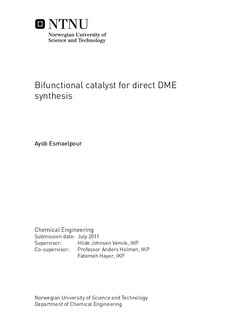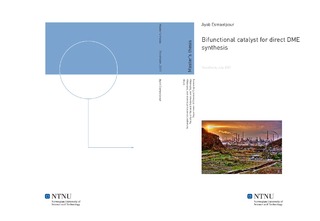| dc.description.abstract | New technologies produce liquids from synthesis gas in the gas to liquids technology (GTL). Dimethyl ether made from synthesis gas is one such possible process. DME is more or less claimed to be a renewable fuel that solves the issues concerning CO2 emissions and global warming. Nowadays, DME is commercially produced by dehydration of methanol using acidic porous catalysts; whereas direct synthesis from synthesis gas in large-scale plants might be more economical. A collection of bifunctional catalysts with different contents and additives has been studied for the direct DME synthesis. In the current study, a sample of CuO?ZnO?Al2O3 was prepared by co-precipitation method. After characterization by XRD, the catalyst was mixed with methanol dehydration catalyst (HZSM-5) with different mass ratios(1,2,4,6 and 8). The activity test for the catalysts was performed in the DME synthesis set-up. The experiment was carried out in a fixed-bed reactor and the temperature range of 235-275°C , the GHSV range of 4500 - 60000nmL/(g_cat h ) and H2:CO ratios of 1,2 and 4 were applied.
According to the results; The bifunctional catalyst with mass ratio of 6 shows the better performance for different GHSVs. The relatively large surface area of the HZSM-5 catalyst provides proper utilization of methanol produced by methanol synthesis catalyst for the ratios up to 6. The bifunctional catalysts with mass ratios of 4, 6 and 8 show the same DME yields at temperature range of 235-255°C. At the higher temperatures, the bifunctional catalysts with mass ratios of 4 and 6 show higher CO conversions and DME yields. H2-rich feeds give better CO conversion and DME yield. The bifunctional catalyst with mass ratio of 6 shows higher CO conversion and by increasing the mass ratio, there will be no increase in CO conversion. According to the results the optimum CuO/ZnO/Al2O3 to HZSM-5 mass ratio could be between 4-6. | |

